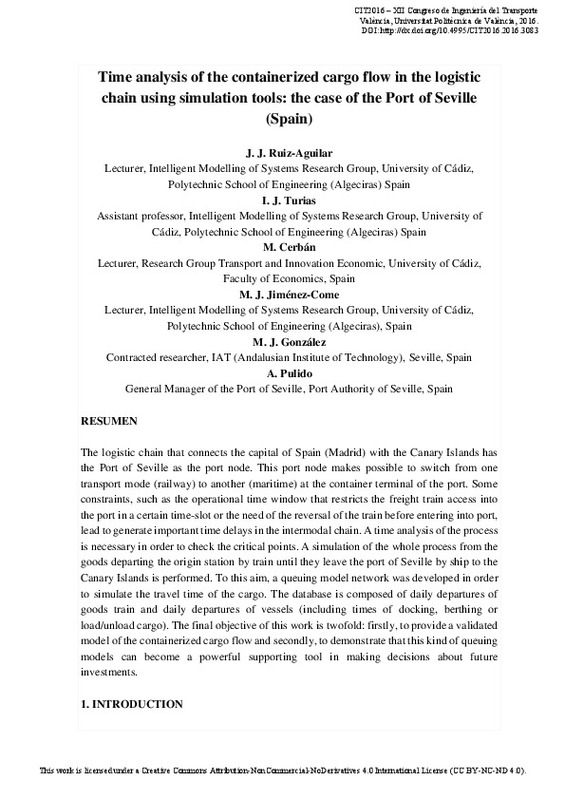JavaScript is disabled for your browser. Some features of this site may not work without it.
Buscar en RiuNet
Listar
Mi cuenta
Estadísticas
Ayuda RiuNet
Admin. UPV
Time analysis of the containerized cargo flow in the logistic chain using simulation tools: the case of the Port of Seville (Spain)
Mostrar el registro sencillo del ítem
Ficheros en el ítem
| dc.contributor.author | RUIZ AGUILAR, JUAN
|
es_ES |
| dc.contributor.author | TURIAS, IGNACIO
|
es_ES |
| dc.contributor.author | CERBÁN, MAR
|
es_ES |
| dc.contributor.author | Jiménez Come, M. J.
|
es_ES |
| dc.contributor.author | GONZÁLEZ, MARÍA
|
es_ES |
| dc.contributor.author | PULIDO, ÁNGEL
|
es_ES |
| dc.coverage.spatial | east=-5.993913600000042; north=37.3608161; name=Sevilla, Espanya | |
| dc.date.accessioned | 2017-10-20T09:46:17Z | |
| dc.date.available | 2017-10-20T09:46:17Z | |
| dc.date.issued | 2016-06-01 | |
| dc.identifier.isbn | 9788460899600 | |
| dc.identifier.uri | http://hdl.handle.net/10251/89729 | |
| dc.description.abstract | [EN] The logistic chain that connects the capital of Spain (Madrid) with the Canary Islands has the Port of Seville as the port node. This port node makes possible to switch from one transport mode (railway) to another (maritime) at the container terminal of the port. Some constraints, such as the operational time window that restricts the freight train access into the port in a certain time-slot or the need of the reversal of the train before entering into port, lead to generate important time delays in the intermodal chain. A time analysis of the process is necessary in order to check the critical points. A simulation of the whole process from the goods departing the origin station by train until they leave the port of Seville by ship to the Canary Islands is performed. To this aim, a queuing model network was developed in order to simulate the travel time of the cargo. The database is composed of daily departures of goods train and daily departures of vessels (including times of docking, berthing or load/unload cargo). The final objective of this work is twofold: firstly, to provide a validated model of the containerized cargo flow and secondly, to demonstrate that this kind of queuing models can become a powerful supporting tool in making decisions about future investments. | es_ES |
| dc.format.extent | 9 | es_ES |
| dc.language | Inglés | es_ES |
| dc.publisher | Editorial Universitat Politècnica de València | es_ES |
| dc.relation.ispartof | XII Congreso de ingeniería del transporte. 7, 8 y 9 de Junio, Valencia (España) | es_ES |
| dc.rights | Reconocimiento - No comercial - Sin obra derivada (by-nc-nd) | es_ES |
| dc.subject | Discret event system | es_ES |
| dc.title | Time analysis of the containerized cargo flow in the logistic chain using simulation tools: the case of the Port of Seville (Spain) | es_ES |
| dc.type | Capítulo de libro | es_ES |
| dc.type | Comunicación en congreso | es_ES |
| dc.identifier.doi | 10.4995/CIT2016.2015.3083 | |
| dc.rights.accessRights | Abierto | es_ES |
| dc.description.bibliographicCitation | Ruiz Aguilar, J.; Turias, I.; Cerbán, M.; Jiménez Come, MJ.; González, M.; Pulido, Á. (2016). Time analysis of the containerized cargo flow in the logistic chain using simulation tools: the case of the Port of Seville (Spain). En XII Congreso de ingeniería del transporte. 7, 8 y 9 de Junio, Valencia (España). Editorial Universitat Politècnica de València. 1509-1517. https://doi.org/10.4995/CIT2016.2015.3083 | es_ES |
| dc.description.accrualMethod | OCS | es_ES |
| dc.relation.conferencename | CIT2016. Congreso de Ingeniería del Transporte | es_ES |
| dc.relation.conferencedate | June 07-09,2016 | es_ES |
| dc.relation.conferenceplace | Valencia, Spain | es_ES |
| dc.relation.publisherversion | http://ocs.editorial.upv.es/index.php/CIT/CIT2016/paper/view/3083 | es_ES |
| dc.description.upvformatpinicio | 1509 | es_ES |
| dc.description.upvformatpfin | 1517 | es_ES |
| dc.type.version | info:eu-repo/semantics/publishedVersion | es_ES |
| dc.relation.pasarela | OCS\3083 | es_ES |








